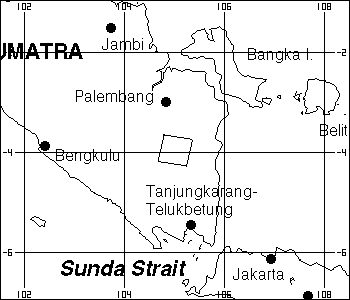
Figure 1: Cast Study Area
中山幹康(東京農工大学・連合農学研究科)
Mikiyasu Nakayama (United Graduate School of Agricultural
Science Tokyo University of Agriculture and Technology)
e-mail: mikiyasu@cc.tuat.ac.jp
要旨:
恒常的に雲量が多い熱帯域においては,土地被覆判別にSARを適用する試みが以前から行われている.最近では,後方散乱係数に加えてインターフェロメトリー処理によるコヒーレンス値を援用することも,主に単一の波長について試みられている.しかし,インターフェロメトリー処理が可能なSARデータのペアを得ることは現実には容易ではないことを考えると,インターフェロメトリーの適用は,(よりデータの取得が容易である)複数の波長における後方散乱係数を適用する場合よりも優れている場合においてのみ妥当と考えられる.本研究では,複数の波長におけるコヒーレンス値と後方散乱係数による熱帯域での土地被覆判別を試みた.得られた結果からは,2つの波長における後方散乱係数のみを適用した場合と,単一の波長でコヒーレンス値と後方散乱係数を適用した場合では,両者の成績はほぼ等しいか,あるいは前者の方がやや優れていると推定される.
Background:
Use of coherence data from operational satellite based SAR sensors (e.g.
on ERS-1/-2 or JERS-1), in addition to ordinary backscatter data, has been
experimented both on C and L band to identify landcover in tropics (Ribbes
et. al., 1999; Siegert and Nakayama, 1999). While coherence data proved
useful to improve accuracy in landcover identification, such data are not
readily available. It is because ERS-1 and
-2 should be in tandem operation mode to secure a pair of ERS SAR data
suitable for interferometry in tropics (Stussi, et. al., 1996), and
repeat-pass interferometry by JERS-1 SAR data is often not feasible
due to a large distance between two orbits. On the other hand, integrated
use of backcatter data by multiple satellites is readily feasible. The
very question to be asked is whether integration of backscatter data on
multiple bands (e.g. C and L band) is either inferior or superior to use
of coherence data. Most of previous researches, on use of
coherence data for landcover identification in tropics, concentrated
on use of data on single band. We therefore still do not have a solid clue
to answer to the very question.
The aim of this study is to evaluate the performance of "integrated
use" of backscatter data on C and L band (by ERS and JERS respectively)
to identify landcover, vis-a-vis the same by combination of backscatter
and coherence data by single satellite.
Methodology and Results:
The performance of SAR data in landcover identification was examined in the following five cases.
Case 1: Backscatter alone by ERS
Case 2: Backscatter and Coherence by ERS
Case 3: Backscatter alone by JERS
Case 4: Backscatter and Coherence by JERS
Case 5: Backscatter by both ERS and JERS
The study was carried out for an area in the southern part of the Sumatra island, Indonesia (see Figure 1). The area has been intensively converted from natural forest into plantation.

Figure 1: Cast Study Area
As shown in the previous study for this area (Stussi, et. al., 1996),
five categories of landcover (namely, forest, bare soil, deforested area,
plantation type 1 and plantation type 2) exist in this study area.
For ERS-1 and -2, the outcome of the previous research (Stussi, et. al.,
1996) was used as it was. Both backscatter and coherence data were
obtained in June 1996, when ERS-1 and -2 were put into tandem operation
mode. As shown in Figure 2, only 2 or 3 classes may be identified with
the backscatter data alone, while 4 classes could be delineated by adding
the coherence data.

Figure 2: Landcover Classification by ERS-1/-2 data [Source:
Stussi, et. al., 1996]
For JERS-1, the backscatter data were obtained in June 1996. The coherence data were calculated out of a pair of SAR data secured in June and October 1996, with return period of 88 days. As shown in Figure 3, only 3 to4 classes may be identified with the backscatter data alone, while 4 classes could be clearly delineated by adding the coherence data.

Figure 3: Landcover Classification by JERS-1 data
Comparing figures 2 and 3, it sounds safe to assume that 4 to 5 classes may be identified by integrating backscatter data on two bands. It represents the best results among the five cases examined.
Conclusion:
The outcome of the study suggests:
Integrated use of backscatter data on two bands by ERS and JERS is as powerful as use of backscatter and coherence data on single band by one of these satellite. In operational terms, difficult-to-obtain coherence data are not absolutely needed to identify landcover. Repeat-pass interferometry is feasible on L band with JERS SAR data in Indonesia even with 88 days of return period, while repeat-pass interferometry is not employable on C band with ERS data in tropics.
Further studies:
Further studies need to be carried out. A caveat for this study is that the training areas on two bands are not necessarily identical. It was because only a graph (i.e. Figure 2) was available on C band, as the outcome of a previous study. A study is now on-going in collaboration with the National University of Singapore in order to carry out the same study but with identical training areas. The initial outcome of this new study has let the author believe that the conclusion reached is robust, while it ought to be numerically verified.
References:
Ribbes, F., Le Toan. T., Floury, N., Wasrin, U.R. (1999): Deforestation Monitoring in Tropical Regions using Multitemporal ERS/JERS SAR and InSAR Data, JERS-1 Science Program '99 PI Reports, NASDA, Tokyo.
Siegert, F. and NakayamaナCM. (1999): Comparison of ERS and JERS SAR data to assess the fire disaster in Kalimantan 1997/1998, ESA/NASDA Workshop on Disaster Management, Unispace III, 22 July 1999, Vienna.
Stussi, N., Kwoh, L.K., Liew, S.C., Singh, K., Lim, H. (1996): ERS-1/2
Interferometry: Some Results on Tropical Forest, ESA Workshop on
Applications of ERS SAR Interferometry, 30 September to 2 October 1996,
Zurich.